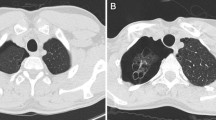Abstract
Background and Objective
This study aimed to investigate the relationship between bleb formation, primary spontaneous pneumothorax (PSP) and pectus excavatum (PE).
Methods
From July 2005 to December 2016, the records of 514 patients with PE who underwent the Nuss procedure were obtained from a prospectively collected database and reviewed. Clinical features, images and treatments were analyzed retrospectively.
Results
The incidence rate of bleb formation was 26.5% in PE patients. The bleb group had a greater body height (174.4 cm vs. 170.4 cm, p < 0.001), a higher Haller index (HI; 4.2 vs. 3.43, p < 0.001) and a higher risk of develo** PSP than the non-bleb group (risk ratio 9.8, p = 0.002). HI values larger than 3.615 had good discriminatory power for predicting bleb formation in patients with PE. With each increase in the HI, PE patients had a 2.2-fold greater odds ratio of bleb formation (odds ratio 2.221, CI 1.481–3.330, p < 0.001).
Conclusion
We discovered that a high percentage of PE patients have bleb formation and a higher risk of PSP, especially those with an HI >3.615. High-resolution computed tomography of the chest may be useful for evaluating both the HI and the presence of blebs in the lungs before performing a corrective surgical procedure.




Similar content being viewed by others
References
Wu T-H, Huang T-W, Hsu H-H, Lee S-C, Tzao C, Chang H et al (2013) Usefulness of chest images for the assessment of pectus excavatum before and after a Nuss repair in adults. Eur J Cardiothorac Surg 43(2):283–287
Park HJ, Kim JJ, Park JK, Moon SW (2016) A cross-sectional study for the development of growth of patients with pectus excavatum. Eur J Cardiothorac Surg 50(6):1102–1109
Nuss D, Kelly RE, Croitoru DP, Katz ME (1998) A 10-year review of a minimally invasive technique for the correction of pectus excavatum. J Pediatr Surg 33(4):545–552
Croitoru DP, Kelly RE, Goretsky MJ, Lawson ML, Swoveland B, Nuss D (2002) Experience and modification update for the minimally invasive Nuss technique for pectus excavatum repair in 303 patients. J Pediatr Surg 37(3):437–445
MacDuff A, Arnold A, Harvey J (2010) Management of spontaneous pneumothorax: British Thoracic Society pleural disease guideline 2010. Thorax 65(Suppl 2):ii18–ii31
Huang TW, Lee SC, Cheng YL, Tzao C, Hsu HH, Chang H et al (2007) Contralateral recurrence of primary spontaneous pneumothorax. Chest 132:1146–1150
Cheng Y-L, Huang T-W, Lee S-C, Wu C-T, Chen J-C, Chang H et al (2010) Video-assisted thoracoscopic surgery using single-lumen endotracheal tube anaesthesia in primary spontaneous pneumothorax. Respirology 15(5):855–859
Huang H, Chien W, Chung C, Chen Y (2019) Pectus excavatum is associated with a higher incidence of primary spontaneous pneumothorax in a young population in Taiwan: a nationwide population-based study. Thorac Med 34(325):47–57
Kılıçgün A, Yakşi O, Ünal M (2019) Is pectus excavatum a risk factor for spontaneous pneumothorax? Haller index measurements in patients with primary spontaneous pneumothorax. Can Respir J 2019:3291628
Hanley JA, McNeil BJ (1982) The meaning and use of the area under a receiver operating characteristic (ROC) curve. Radiology 143(1):29–36
Sahn SA, Heffner JE (2000) Spontaneous pneumothorax. N Engl J Med 342(12):868–874
Mitlehner W, Friedrich M, Dissmann W (1992) Value of computer tomography in the detection of bullae and blebs in patients with primary spontaneous pneumothorax. Respiration 59(4):221–227
Amjadi K, Alvarez GG, Vanderhelst E, Velkeniers B, Lam M, Noppen M (2007) The prevalence of blebs or bullae among young healthy adults: a thoracoscopic investigation. Chest 132(4):1140–1145
Peters RM, Peters BA, Benirschke SK, Friedman PJ (1978) Chest dimensions in young adults with spontaneous pneumothorax. Ann Thorac Surg 25(3):193–196
Casha AR, Manché A, Gatt R, Wolak W, Dudek K, Gauci M et al (2014) Is there a biomechanical cause for spontaneous pneumothorax? Eur J Cardio-thoracic Surg 45(6):1011–1016
Casha AR, Manché A, Camilleri L, Gatt R, Dudek K, Pace-Bardon M et al (2016) A biomechanical hypothesis for the pathophysiology of apical lung disease. Med Hypotheses 92:88–93
Sakamoto K, Ando K, Noma D (2014) Spontaneous bilateral pneumothorax resulting from iatrogenic buffalo chest after the Nuss procedure. Ann Thorac Surg 98(4):1463–1465
Matsuoka S, Miyazawa M, Kashimoto K, Kobayashi H, Mitsui F, Tsunoda H et al (2016) A case of simultaneous bilateral spontaneous pneumothorax after the Nuss procedure. Gen Thorac Cardiovasc Surg 64(6):347–350
Lee Y, Kim YJ, Ryu HY, Ku GW, Sung TY, Yoon YS et al (2018) Thoracic scoliosis in patients with primary spontaneous pneumothorax. Korean J Thorac Cardiovasc Surg 51(4):254–259
Lee KH, Kim KW, Kim EY, Lee J-I, Kim YS, Hyun SY et al (2014) Detection of blebs and bullae in patients with primary spontaneous pneumothorax by multi-detector CT reconstruction using different slice thicknesses. J Med Imaging Radiat Oncol 58(6):663–667
Funding
This research received no specific grant from any funding agency in the public, commercial or not-for-profit sectors.
Author information
Authors and Affiliations
Corresponding author
Ethics declarations
Conflict of interest
All authors declare no conflict of interest.
Additional information
Publisher's Note
Springer Nature remains neutral with regard to jurisdictional claims in published maps and institutional affiliations.
Rights and permissions
About this article
Cite this article
Huang, HK., Huang, YJ., Lin, KH. et al. Severity of Pectus Excavatum is a Risk Factor for Primary Spontaneous Pneumothorax. World J Surg 44, 2035–2041 (2020). https://doi.org/10.1007/s00268-020-05412-6
Published:
Issue Date:
DOI: https://doi.org/10.1007/s00268-020-05412-6



